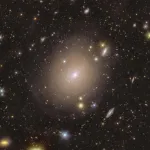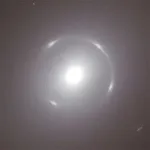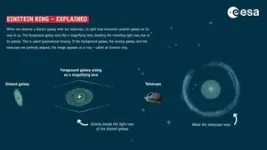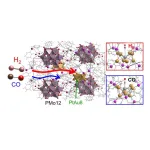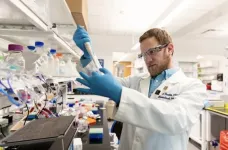(Press-News.org) Euclid blasted off on its six-year mission to explore the dark Universe on 1 July 2023. Before the spacecraft could begin its survey, the team of scientists and engineers on Earth had to make sure everything was working properly. During this early testing phase, in September 2023, Euclid sent some images back to Earth. They were deliberately out of focus, but in one fuzzy image Euclid Archive Scientist Bruno Altieri saw a hint of a very special phenomenon and decided to take a closer look.
“I look at the data from Euclid as it comes in,” explains Bruno. “Even from that first observation, I could see it, but after Euclid made more observations of the area, we could see a perfect Einstein ring. For me, with a lifelong interest in gravitational lensing, that was amazing.”
The Einstein Ring, an extremely rare phenomenon, turned out to be hiding in plain sight in a galaxy not far away. The galaxy, called NGC 6505, is around 590 million light-years from Earth, a stone’s throw away in cosmic terms. But this is the first time that the ring of light surrounding its centre is detected, thanks to Euclid’s high-resolution instruments.
The ring around the foreground galaxy is made up of light from a farther out bright galaxy. This background galaxy is 4.42 billion light-years away, and its light has been distorted by gravity on its way to us. The far-away galaxy hasn’t been observed before and doesn’t yet have a name.
“An Einstein ring is an example of strong gravitational lensing,” explains Conor O’Riordan, of the Max Planck Institute for Astrophysics, Germany, and lead author of the first scientific paper analysing the ring. “All strong lenses are special, because they're so rare, and they're incredibly useful scientifically. This one is particularly special, because it’s so close to Earth and the alignment makes it very beautiful.”
Albert Einstein’s general theory of relativity predicts that light will bend around objects in space, so that they focus the light like a giant lens. This gravitational lensing effect is bigger for more massive objects – galaxies and clusters of galaxies. It means we can sometimes see the light from distant galaxies that would otherwise be hidden.
If the alignment is just right, the light from the distant source galaxy bends to form a spectacular ring around the foreground object. These Einstein rings are a rich laboratory for scientists. Studying their gravitational effects can help us learn about the expansion of the Universe, detect the effects of invisible dark matter and dark energy, and investigate the background source whose light is bent by dark matter in between us and the source.
“I find it very intriguing that this ring was observed within a well-known galaxy, which was first discovered in 1884,” says Valeria Pettorino, ESA Euclid Project Scientist. “The galaxy has been known to astronomers for a very long time. And yet this ring was never observed before. This demonstrates how powerful Euclid is, finding new things even in places we thought we knew well. This discovery is very encouraging for the future of the Euclid mission and demonstrates its fantastic capabilities.”
By exploring how the Universe has expanded and formed over its cosmic history, Euclid will reveal more about the role of gravity and the nature of dark energy and dark matter. The space telescope will map more than a third of the sky, observing billions of galaxies out to 10 billion light-years. It is expected to find around 100 000 strong lenses, but to find one that’s so spectacular – and so close to home – is astonishing. Until now, less than 1000 strong lenses were known, and even fewer were imaged at high resolution.
“Euclid is going to revolutionise the field, with all this data we've never had before,” adds Conor.
Although this Einstein ring is stunning, Euclid’s main job is searching for the more subtle effects of weak gravitational lensing, where background galaxies appear only mildly stretched or displaced. To detect this effect, scientists will need to analyse billions of galaxies. Euclid began its detailed survey of the sky on 14 February 2024 and is gradually creating the most extensive 3D map of the Universe yet. Such an amazing find, so early in its mission, means Euclid is on course to uncover many more hidden secrets.
END
Euclid discovers a stunning Einstein ring
2025-02-10
ELSE PRESS RELEASES FROM THIS DATE:
Biotech in Germany has significant potential, but lack of collaboration hampers growth
2025-02-10
The report “Assessing Deep-Tech Innovation Hubs in Germany: The Case of Biotechnology” evaluates Germany’s performance in deep-tech innovation within biotech using a comprehensive index and examines five key hubs: Berlin, Heidelberg, Munich, Nuremberg-Erlangen, and Stuttgart. These hubs were analyzed in terms of fundamental research, research and development in biotech, startup activity, public infrastructure, and business environment.
Berlin, Munich, and Heidelberg are the leading biotech hubs
Berlin leads the index due to its strong public infrastructure ...
Does pain affect cancer survivors’ use of non-opioid substances?
2025-02-10
Experiencing pain may increase the odds that cancer survivors will use cigarettes and cannabis, according to a recent study published by Wiley online in CANCER, a peer-reviewed journal of the American Cancer Society. The study also found that cigarette smoking and pain are linked to more treatment-related side effects and worse health among cancer survivors.
Pain and use of cigarettes, e-cigarettes, alcohol, and cannabis commonly occur together in the general population. To characterize pain in relation to such non-opioid substance ...
Scientists find that a playful approach to life activates ‘lemonading’, which helps people cope with adversity
2025-02-10
Scientists have found that taking a playful approach to life doesn’t mean you don’t take your situation seriously, but it can mean you cope with it better. By surveying people about their experiences during a Covid-19 lockdown, they learned that more playful people were more positive about the future and coped more actively and creatively. Life gave them lemons, and they made lemonade.
“Our study revealed that playfulness and resilience are intimately connected through what we call ‘lemonading’ — the ability to imagine ...
Candidate genes in canine hepatocellular carcinoma for molecular targeted therapy
2025-02-10
Unresectable canine hepatocellular carcinoma (HCC) has limited nonsurgical treatment options. Sorafenib is a targeted therapy for unresectable canine HCC. However, there are limited reports on the expression of target genes. Therefore, the efficacy of the targeted therapies for canine HCC remains unclear.
In HCC, the prognosis is generally good when complete surgical resection is possible. Unresectable nodular and diffuse HCC have a poor prognosis and limited nonsurgical treatment options. In humans, systemic therapies including ...
Opioid prescriptions in the ED linked to small increases in future opioid use, hospitalizations
2025-02-10
Opioid prescriptions in the emergency department (ED) were associated with small increases in later opioid prescriptions and hospital admissions, found new research published in CMAJ (Canadian Medical Association Journal) https://www.cmaj.ca/lookup/doi/10.1503/cmaj.241542.
To understand the relationship between opioid prescribing in the ED and subsequent harm, researchers looked at opioid prescribing at all Alberta EDs from 2010 to 2020. Of the more than 13 million visits, 689 074 patients (5.3%) filled an opioid prescription. The researchers found that opioid prescriptions did not increase the risk of ...
During pandemic, playful people were remarkably resilient, OSU research shows
2025-02-10
CORVALLIS, Ore. – Adults with high levels of playfulness showed strong resilience during the COVID-19 pandemic compared to less playful individuals, new research shows.
The study led by Xiangyou “Sharon” Shen of Oregon State University is important because playfulness is a vital but underappreciated resource for building resilience and maintaining well-being during difficult periods such as the pandemic, Shen said. And it’s a resource that individuals can cultivate.
“Understanding how playful people navigate adversity can inform interventions and strategies to help people cope with stress and uncertainty,” said Shen, an assistant professor ...
Tracing gas adsorption on “crowns” of platinum and gold connected by nanotunnels
2025-02-08
Tokyo, Japan – Researchers from Tokyo Metropolitan University have elucidated how hydrogen and carbon monoxide is adsorbed into solids containing a crown-motif structure of platinum and gold. Using quick-scan X-ray absorption measurements and theoretical calculations, they studied a solid of [PtAu8(PPh3)8]-H[PMo12O40] called PtAu8-PMo12 and found that gas adsorption is affected strongly by the dimension of nanoscale voids in the structure. This highlights the importance of engineering voids in materials for next generation sensors and gas separation.
Ligand-protected metal clusters have been a source of ...
Rare bird skull from the age of dinosaurs helps illuminate avian evolution
2025-02-08
A new study in Nature describing a fossil of a nearly complete and intact bird skull from Antarctica is shedding light on the early evolution of today’s birds and avian diversity at the end of the Age of Dinosaurs.
The skull is from Vegavis iaai, an extinct duck-like bird that lived during the Late Cretaceous, just before non-avian dinosaurs went extinct. It’s one of very few 3D bird skulls known to science from the Cretaceous — a 79-million-year geological period and the last era when ...
Researchers find high levels of the industrial chemical BTMPS in fentanyl
2025-02-08
A UCLA research team has found that drugs being sold as fentanyl contain high amounts of the industrial chemical bis(2,2,6,6-tetramethyl-4-piperidyl) sebacate, or BTMPS. This new substance of concern emerged in the illicit drug supply nearly simultaneously in multiple U.S. locations from coast-to-coast.
From June through October 2024, the team quantitatively tested samples of drugs sold as fentanyl that had high levels of the chemical, which belongs to a class of compounds called hindered amine light stabilizers ...
Decoding fat tissue
2025-02-08
As many as 40% of Americans are obese, putting them at an increased risk for high blood pressure, diabetes, stroke, heart disease and certain cancers, according to the CDC. New research from the University of Delaware aims to tackle the issue by investigating obesity at the gene level.
Principal investigator Ibra Fancher, assistant professor of kinesiology and applied physiology in UD’s College of Health Sciences, discovered significant differences in gene expression in adipose tissue, more commonly known as fat. Formerly considered fat storage, adipose tissue is now recognized as a vital ...
